From: Inverness to Culbokie
Distance: 12m / 19.3km
Cumulated distance: 1073m / 1727km
Percentage completed: 90.6
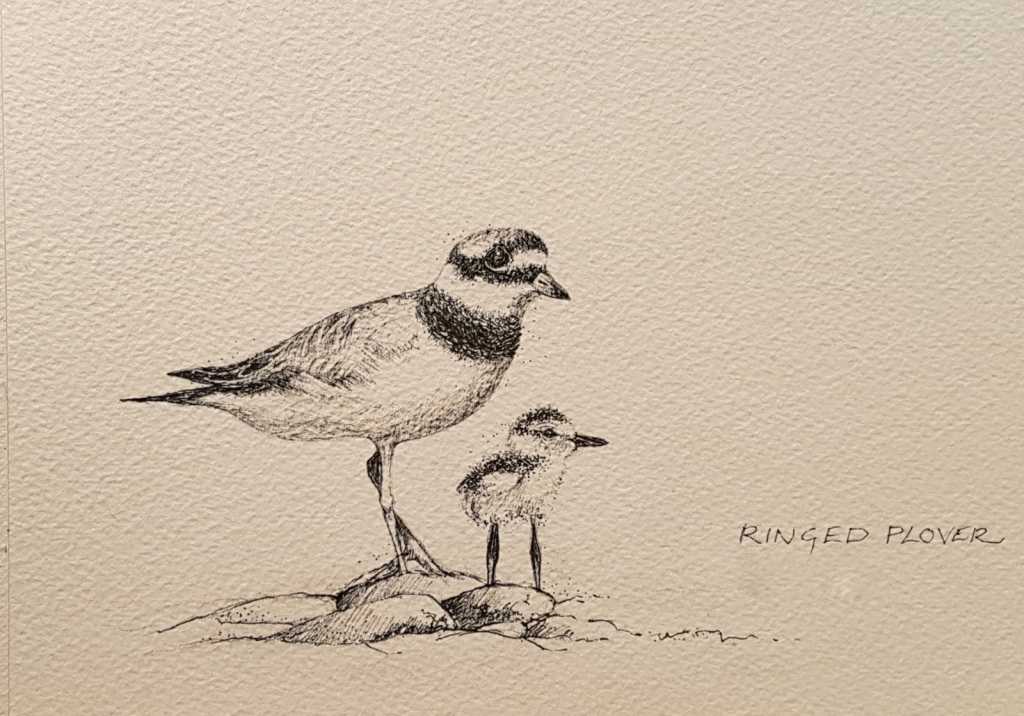
I was back on my own again this morning for the final stretch of Walking The Black Dog. My plan is to walk the John o’Groats Trail which begins in Inverness. All along I’ve felt this will be the most difficult part of the journey .. the Trail is very new and in parts not well sign-posted, according to other bloggers. It’s also boggy and there are many fences to negotiate. But the alternative is to walk the busy A9, which has precious little path for walkers. Some LEJOGers have even opted to walk from north to south so that they get this worst bit of the walk over first.
Yesterday evening the good weather showed River Ness up in its best light and I even had a grey heron performing to give me a perfect silhouette for my photos. It was a balmy evening and I was delighted that another old friend, Great Aunt Agatha, had been kind enough to make the effort and join me for dinner and a couple of whiskies .. this is a terrific new discovery of mine, the after dinner nip of Glengroin.
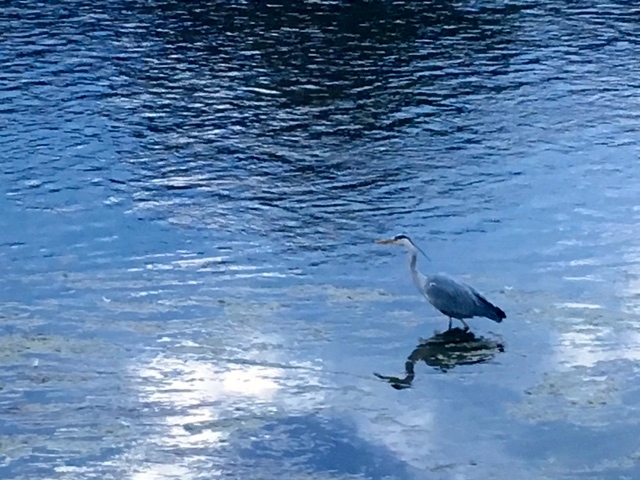
Grey heron in the evening light

Looking north along the River Ness
Walking alongside the river to join the Way this morning, I passed a 9 foot sculpture of the Three Virtues: Faith, Hope and Charity. The girls have moved around a fair amount considering each of them weighs over four tons. They first stood on top of the Young Men’s Christian Association which was opened in Inverness in 1859. The building was demolished a century later and the virtues were relegated to a burgh surveyor’s yard. A passing antique dealer took a shine to them and transported them all the way to his garden in the Orkneys where they remained until very recently. In 2011 they made their way back to Inverness, were lovingly restored and now stand on the banks of the Ness. Faith has her bible, Hope her anchor and Charity her cornucopia.
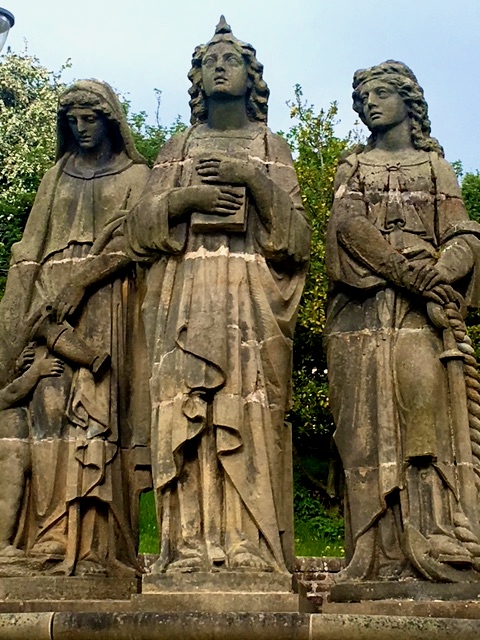
The Virtues
The John o’Groats Way starts in front of Inverness Castle which sits on a cliff overlooking the River Ness. The red sandstone building that exists today is just the most recent of a clutch of castles which have stood on the site. The first was supposedly where Macbeth murdered Donald I of Scotland, way back in the 11th century. A large, bronze statue of the spirited Flora MacDonald stands in front of the castle. You’ll remember she was the woman who heroically rowed Bonnie Prince Charlie over to Skye. Looks to me as if Katie Perry took some wardrobe advice from Flora.

Flora Macdonald
I planned to follow the river out of Inverness and then use the kilometre-long Kessock Bridge to cross over the Beauly Firth … in Scotland a firth is an inlet or a loch. Before I climbed up to the bridge however, I came across this curiosity, in amongst the warehouses and storage containers of the industrial estate. Cromwell’s Clock Tower is all that now remains of the Protectorate’s fort in Inverness. The fort, which became known as the Citadel of Inverness started in May 1652 and was comleted in 1658, the year of Cromwell’s death. When it was built it accommodated a garrison of around 1000 men. But it didn’t stand for long and when Charles II came to the throne in 1660 he was pressurised by the Highland clan chefs that all citadels in Scotland built by the English be demolished and the soldiers who were stationed in Inverness be sent home. The citadel’s life was short-lived .. it was demolished in 1662.
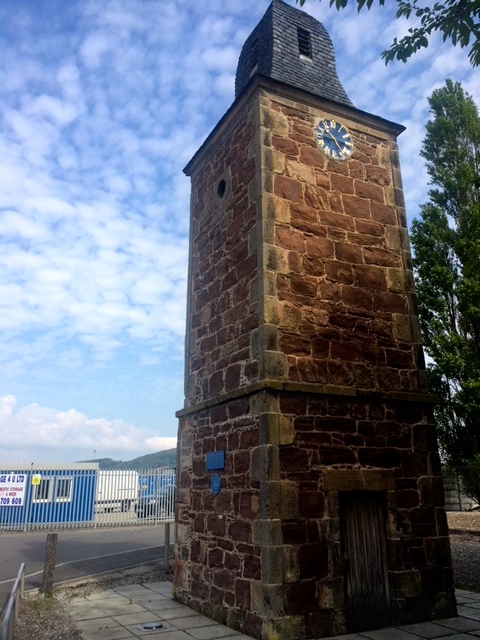
Cromwell’s clock tower
When the Kessock Bridge was built it took the place of the ferry which had crossed the water since the 15th century. Were it not for the bridge my walk would have been substantially longer today. It carries the A9 .. my first brush with the road that so many walkers have developed such a loathing for during their End to End walk. And wow, it was busy. There was a chance of seeing dolphins below in the water, as the Dolphin and Seal Centre is close by but sadly today they were all taking their swims elsewhere. The Black Isle, the Moray coast and Loch Ness could all be seen from the bridge.
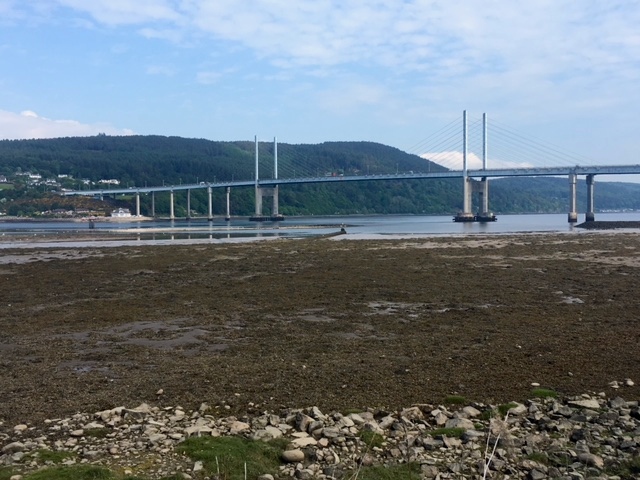
The Kessock Bridge
If the bridge looks at all familiar to German readers it’s because it was largely based on the Rees Bridge over the Rhine at Dusseldorf. It was designed to withstand wild Scottish waters and winds of up to 99mph, as well as accommodate potential movement of the Great Glen fault in its northern abutment. This was achieved by the addition of two 400 tonne hydraulic buffers. Today, with the sun shining, it looked very attractive. And the views from the bridge were equally lovely.

Inverness marina
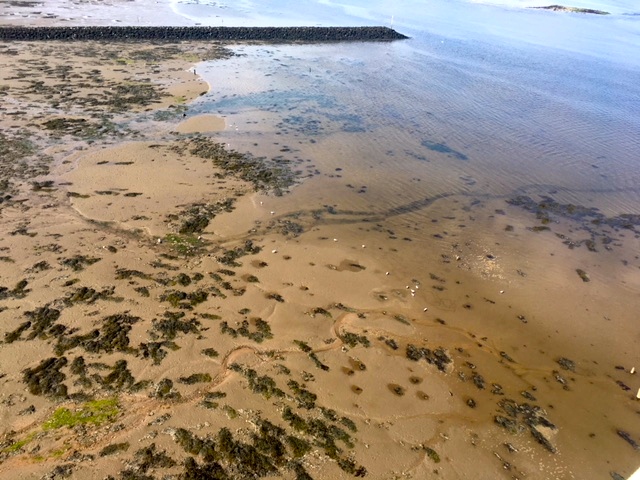
The Estuary beneath the bridge
Having no idea of the great treats that were to happen later in the day, my spirits started to flag after I crossed the bridge. I’ll admit to feeling a real misery-guts as my foot hurt more and more as I plodded on. During my rest day I’d been to A&E at Inverness Hospital to check it out. Stress fractures had been ruled out by the X-Ray but the doc confirmed it was definitely plantar fasciiitis. The treatment? Rest. Terrific. Apart from icing, stretching and anti-inflammatories there wasn’t a lot else that could be done. But the good news was that I was not going to be doing any irreparable damage by carrying on with the walk .. just incurring a longer recovery period. Rather stupidly at breakfast I took a couple of cocodomil .. a combo of codeine and paracetemol. By the time I was crossing the bridge I felt exceedingly tired and was probably not walking in the straightest of lines. At which point the good Samaritans Kate and George intervened. ‘Are you OK, dear?’, asked Kate at the service station … ‘only I’ve been watching you walking and you don’t look very well’. Cutting a long story short the two loveliest of people took me back to their home, made me tea and fed me avocado on toast, while I rested my foot. Listening to their stories, I realised I was only one in a long line of waifs and strays they’ve picked up and revived over the years .. including cats, dogs and humans. I will remain eternally grateful to them.
Watered and well fed I continued on my way to Munlochy, feeling considerably stronger. Rather aptly there’s a wonderful Clootie Well at Munlochy. It’s a healing well which was dedicated to St Boniface. Although he was the patron saint of Germany, Boniface was born in Devon. All around there were colourful rags or ‘cloots’ hanging from trees. It’s said that pilgrims would come to hang a piece of clothing belonging to a sick relation or friend, in the hope of curing their illness. Before tying the clootie to the tree, it would be dipped in the well. It was important only to ask for help with a long-term illness as the cloth disintegrated at the same pace as the sickness was cured. And woe betide anyone stealing a cloth .. they would be visited by the very same ailment that had sickened the original pilgrim. Somehow I forgot to take a photo of the scene but here is someone else’s picture ..
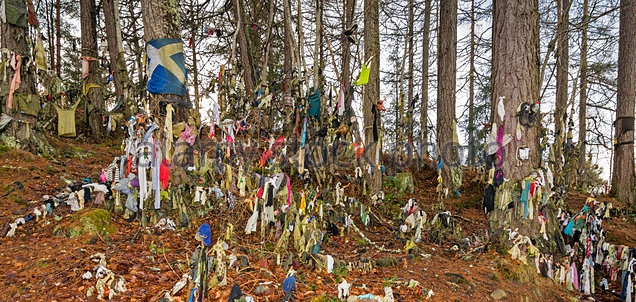
The route today took me through many woods: Drumsmittal Wood, Schoolhouse Wood, Bellton Wood, Upper Knockbain Wood and finally Culbokie Wood beyond which is Culboke, which was my destination for the evening. Culbokie is a village whose name means ‘the haunted nook’. It’s a small village on the north side of the Black Isle named either because it never snows there or because the soil is particularly fertile .. take your pick. Either way the Black Isle is not an isle, being firmly attached to the mainland in the west, although surrounded on three sides by the Cromarty Firth to the north, the Beauly Firth to the south, and the Moray Firth to the east. All names beautiful when spoken aloud with a Scottish accent. The Black Isle was one of the earliest parts of the northern Highlands to experience the clearances .. more of which later .. and was settled with many Lowland shepherds and farmers, especially from the north east. In addition to its Gaelic heritage, the Black Isle also had its own dialect of North Northern Scots, used mainly among fisherfolk in Cromarty, which became extinct in October 2012, when Bobby Hogg, the last native speaker died.
The route between Munlocky and Culbokie was very pastoral and unbelievably green with a strong equine flavour.

Looking east
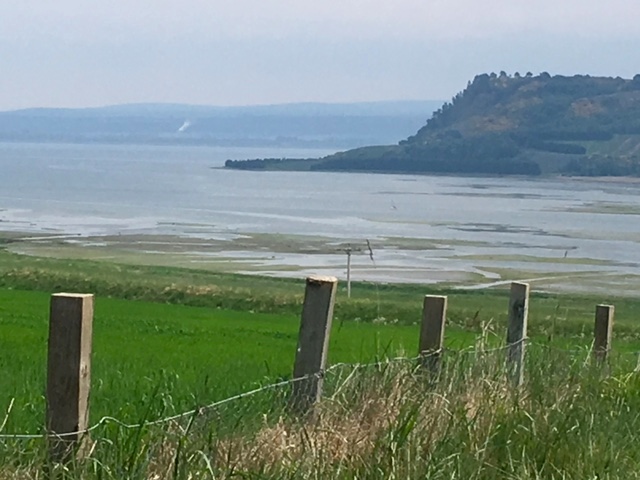
The Moray Firth

Fields and fields of horses
My stop for the night was just a little north of Culboke: Netherton Farm B&B. And what a treat awaited me there! Nine black labrador puppies, just five weeks old! All utterly adorable and just as keen to get into my rucksack as I was to kidnap them!

Welcome to the village
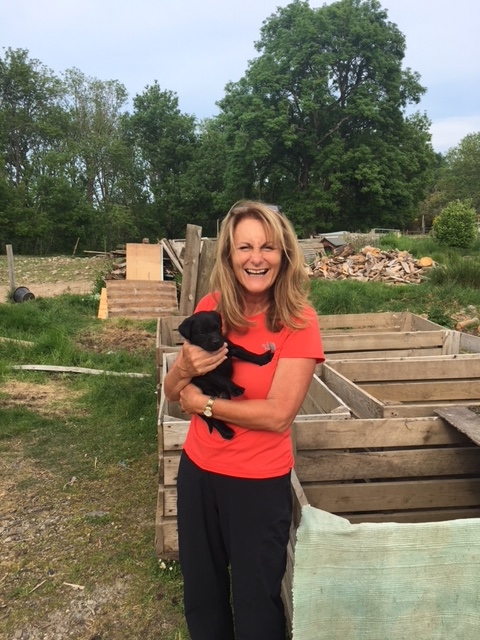
How happy am I!
The very kind owner of the farm zipped me up the road for me to have my dinner at the local pub. Sending off pictures of the adorable pups to friends, I had my head well buried in my phone. And then to my total disbelief I heard a familiar voice saying, ‘I thought I’d find you in the pub’. It was Gus, our son .. travelled all the way from Sydney to surprise me!! My mouth must have stayed open as I remained speechless for a good few minutes, entertaining all the punters in the pub. I have NEVER been so surprised .. well, not since my husband pitched up in Westard Ho! What a day. I am in total heaven!
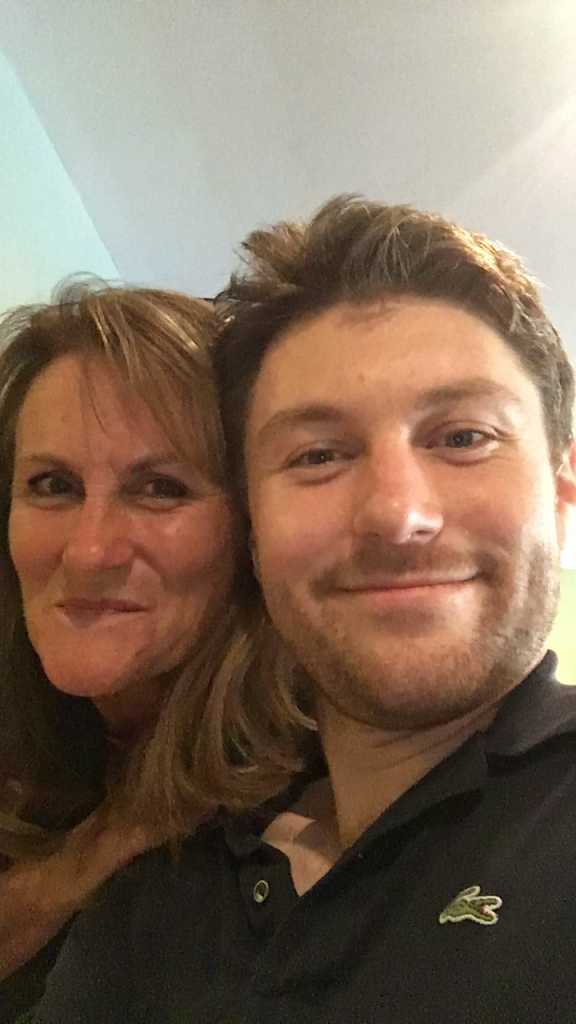
Gorgeous boy
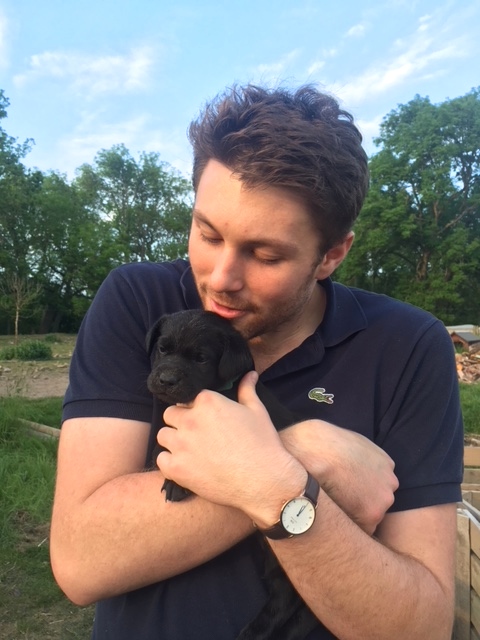
Like mother like son
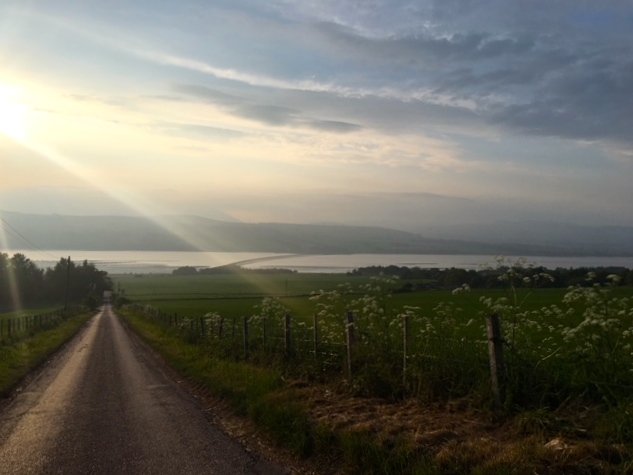
All’s well that ends well ..
Black Dog Tails
Service Dog Avalon is a huge help to Monica Johnson who has a spinal cord injury.

![]()


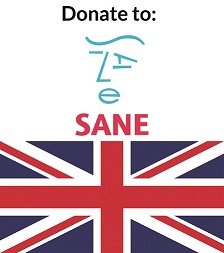
Dear Jules – ouch!! Your poor feet – so sorry – they really have done you proud though after such a long journey. And Gus!! I bumped into him in Sydney weeks ago so was waiting for the joy on the day he arrived out of the blue ❤️ And nine black lab puppies – they must have seen you coming!
Keep going intrepid one – we know you won’t fail now. Enjoy the remaining days of Bonnie Scoortland. Lots of love xx
Thank you from the bottom of my heart, Frannie .. it was one of the best days ever yesterday! A very well kept secret among a select Sydney few! Still can’t quite believe it … xx
So glad Gus is with you. Patrick had told me at the Wwom that he was coming out as a surprise towards the end. I’m sure you are absolutely thrilled as I’m sure it was tough being on your own today after such wonderful company the past few weeks.
The pups look great.
Bosco passed an overnight test last night with a new dog sitter. She has a 1 yr old Great Dane and apparently they did great together!!! So now we have somewhere to leave him when we are all out of town. Even at 13 1/2 he still can’t look after himself!
Apart from the arrival of Patrick in Westward Ho! I have never been so surprised! It was amazing .. and not only I was in tears but also the total strangers on the next door table! So glad to here Bosco has approved a new sitter for himself! xx
Good on you, Gus!
More bagpipe music: this one called Bonnie Black Isle (not to be confused with Dark Isle), visible from where Jules is. If I were to make a documentary about the great trek, I’d use this music as the soundtrack with pictures of Jules picking (lately limping) her way through wonderful scenery, the many manifestations of spring (lambs, ducklings, bluebells,…) and of course the many black dogs to match the Isle
https://www.youtube.com/watch?v=-cIij7zWdN0
Thank you lovely Piper Frothie .. for helping to organise such a fabulous surprise. You boys are the best. xx
What a wonderful surprise at the end of a difficult day – black labrador puppies and a son! Hope the foot doesn’t cause you too much grief in this final stretch.
Thank you Marianne .. difficult to top yesterday!
Ah Jules what a wonderful wonderful surprise ! Well done Gus :))))) wishing you a wonderful sunny few days ahead. Xxx
Reminded me of the day that Swampy surprised you for your birthday! Think my face looked just like yours! xx
Fabulous ‼️‼️‼️❤️
Thank you, Nigel! x
Jules, so lovely your son surprised you just when your spirits were low and now you will have company. Would have been hard to walk alone with pain in your foot. I will be thinking of you during these last days of your journey and hope most fervently that the pain eases. We used lanes and beach/coast when we could from Inverness but inevitably they led to the A9 for the final days. I shall be interested to read of the new ways you write about. xx
Thank you Marilyn .. we’re going to try to be inventive with the route and use the new JoG route. Will be much more fun with him. x
So sweet! I can’t imagine anything better to help you forget your injuries! Xxx
You are so right .. he’s totally the right medicine for me! xx
What a great day !
It’s ALL happened today !
PKD
It was indeed a stellar day! Thank you for your continued support. So much appreciated.
What a great boy and so glad he’s with you – was beginning to get a bit worried. Take care you’ve done an amazing job
Lots of love
Donna
Thank you Donna .. great getting your message. Not long to go now ..
Well done Gus!!! Perfect timing by the sounds of it
Hang in there Jules 😁👍
Totally perfect timing! x
What a delightful surprise for you. And the end is in sight (almost). Hoping the PF stays manageable for the last few(!) miles.
Saw John o’Groats for the first time on a signpost! Very exciting. Hope all is well with you and your walking.
Gus, ‘good on ye maaate’
Just, what a wonderful surprise, and just when you need it. Fantastic xx
Thanks Ilse. It was certainly a case of perfect timing. x
Good on you for keeping on, Jules – despite your painful foot! I hope having your son with you now will take your mind off it a little as you accomplish the last part of your journey. What a wonderful surprise! And at least the weather seems to be holding…
He has been amazing today .. all the chat we’ve had, catching up on 3 months has certainly distracted me. Thanks so much for your message of encouragement. x
You will be ok I am sure. You have proved yourself and demonstrated to yourself that you can overcome the adversities whilst taking pleasure in the whole enterprise – you are truly motivated.
My own passage through Wester Ross in northern Scotland was a mixed bag but here is the most difficult day I had, but the achievement gave me a boost.
Day 68, Sunday 22nd June, Inverlael to Knockdamph Bothy, 10.5 miles
“The rain stopped briefly as I packed up but started again. The route went on forestry road for a while, but then I spent
ages looking for a path branching off up a very steep hillside. Much new forestry road work had been done here and the profile of the road altered, and I suppose the start of my track had been obliterated. In the end I took a compass bearing
from a known GPS reading and went straight up the hillside which consisted of felled forest, bracken and thick heather.
After fifteen minutes I hit another forest road and then found my track leading off it. This track went endlessly upwards and I was walking directly into at least a force seven gale and driving rain which persisted most of this very demanding day. The track ended and became a path which then disappeared necessitating walking on a compass bearing across several kilometres of featureless moorland and bog and peat hags to reach a river. The river cut into a ravine and every few hundred yards side ravines fed into the main one and all these had to be negotiated steeply down and up with no path. Even looking at the map and taking GPS readings in these conditions is a trial. At a point which had to be identified I branched away from the river to climb over a pathless bealach and descend to Loch an Daimh. The route now followed the
edge of this loch to arrive at last at the bothy. It was 4:30pm. In the past I have poked a bit of fun at bothies, but I’m telling you that when you need one they are the best thing in the world. I was not exhausted when I arrived, but fairly damp and starting to get cold, but I was elated to have managed this tough journey properly and under control. It had only been about eleven miles, but it had taken me eight hours.
What an amazing account, Conrad. I can well see how the bothy was incredibly welcoming. I think these walks do a lot to make us humble.
One of my favourite posts – So nice to see you and Gus together. Cannot believe how far you have come – You are incredible! Hope your feet are doing ok xxx
Thank you so much, darling .. I’m still wearing a broad smile after Gus’ arrival. One foot is great .. the other not so much but I’ve had stern words with it so it should hold out. xx
Dearest Jules,
The more you walk, the more surprises you have. I think those black lab pups have waited for you along! at least one of them need to be called Jules.
What a gorgeous surprise to see Angus, what a priceless way to be welcome at the end of the day!
I hope your feet will keep up a few more days.
Go Jules
Lots of love
Amely
Yes, I have been blessed with surprises .. I couldn’t believe it last night when he walked in! xx
I think they are going to have to count how many puppies they have when you leave; surely they won’t miss one or even two! What a fabulous surprise for you, well done Angus but bet he’s as excited to see you and join in in the delights of the last leg, even if it is the A9. You’d think the plantar fasciitis could have had the decency to wait a couple of weeks before setting in. Poor you, but marvel in your achievement: on track, on schedule, smiling, looking great, not grumbling and a slave to us by writing this fabulous blog. Hope Piper Frothie is putting in the practise for a welcome home performance! Lots and lots of love xx
Wonderful getting your messages .. and will be so good to see you the weekend after to properly celebrate. Sending much love from both of us xx
Hi Jules,
Nothing to add to all the lovely other comments today. Just plain fantastic, how sweet of Gus to be able to carry you over the finishing line – knowing you, of course not literally!
Sending lots of love to both of you, Birgit
Thank you, Birgit .. it was a wonderful day, in the end. I’ll have three days by myself at the end but his visit is making all the difference. xx
What a wonderful day! You were already so happy with the pups ( isn’t it a sign that you must get one?), Gus arriving when you thought he wasn’t going to make it, how fantastic, that will keep you going for your last part of the mammoth trek you have made you incredible human being! Love to you both Xxxx
Love getting your messages, Shauna. Thank you so much for your support and encouragement .. and yes, I think a puppy is in order! x
Perfect end to the day. Well done Angus.
He came at just the right time! x
I was feeing so sad and concerned for you – and then read about Gus’s arrival and started to cry in the airport lounge. Hurray! Will he see you to the end?
Oh Angie .. how lovely. Thank you SO much. Gus will be with me till Sunday morning and I finish on Tuesday, a week today. Can’t quite believe it. x
Glad you enjoyed the surprise Jules! Hope you two enjoy your journey together!!!
Thank you, Mary .. so good to get your messages. x
Love this post Jules, how funny that often on days when faced with adversity something or someone is sent to pull you through and give you joy. Not long now x
Thank you, Jo .. it really was a day of two halves! x